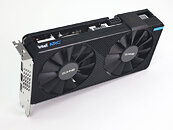
Intel Arc A770 and A750 Graphics Cards Start Selling Worldwide
Intel announced the general availability of the Arc A770 and A750 performance-segment desktop graphics cards. This includes Intel's reference-design Limited Edition cards, and custom-design ones by the likes of ASRock, Gunnir, and Acer, among other OEMs. The A750 has a baseline price of USD $289, the A770 8 GB at $329, and the A770 16 GB at $349.
Based on the Xe-HPG "Alchemist" graphics architecture, the A750 and A770 are carved out of the same 6 nm ACM-G10 silicon. The A750 is configured with 28 Xe Cores, 448 EU, or 3,584 unified shaders; whereas the A770 maxes it out with 32 Xe Cores, 512 EU, or 4,096 unified shaders. Both cards get 256-bit wide GDDR6 memory interfaces, and while the A750 uses 16 Gbps memory (512 GB/s bandwidth); the A770 has 17.5 Gbps (560 GB/s).
Based on the Xe-HPG "Alchemist" graphics architecture, the A750 and A770 are carved out of the same 6 nm ACM-G10 silicon. The A750 is configured with 28 Xe Cores, 448 EU, or 3,584 unified shaders; whereas the A770 maxes it out with 32 Xe Cores, 512 EU, or 4,096 unified shaders. Both cards get 256-bit wide GDDR6 memory interfaces, and while the A750 uses 16 Gbps memory (512 GB/s bandwidth); the A770 has 17.5 Gbps (560 GB/s).




























































